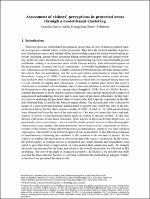Chapter Assessment of visitors’ perceptions in protected areas through a model-based clustering
| dc.contributor.author | Sarra, Annalina | |
| dc.contributor.author | Evangelista, Adelia | |
| dc.contributor.author | di battista, tonio | |
| dc.date.accessioned | 2022-06-01T12:20:17Z | |
| dc.date.available | 2022-06-01T12:20:17Z | |
| dc.date.issued | 2021 | |
| dc.identifier | ONIX_20220601_9788855184618_535 | |
| dc.identifier.issn | 2704-5846 | |
| dc.identifier.uri | https://library.oapen.org/handle/20.500.12657/56350 | |
| dc.description.abstract | Protected areas are well-defined geographical spaces that, in view of their recognized, natural, ecological or cultural values, receive protection. They have the twofold mandate of protection of natural resources and providing a space for nature-based tourism activities. In the last years, the nature-based tourism is experiencing positive and sustainable growth worldwide. Understanding the value attached by visitors to their destination and know their assessment on various activities in which they are engaged during their stay is a key element in shaping tourist’s satisfaction. Objective of this research was to identify the profiles of visitors to tourist destinations within Natural Park of Majella (Abruzzo region, Italy) and to assess the link with their satisfaction. The data for this study were collected by means of a structured questionnaire administrated to tourists who visited the sites of the protected area during the last three summer months. A total of 150 valid questionnaires were obtained and form the base of the data analysis. Through a Bayesian model-based clustering, better known as Bayesian Profile Regression, we partition visitors into clusters, characterized by similar profiles in terms of their demographic characteristics (age, gender, education attainment), as well as, in terms of the features of their travel behaviour (accommodation, length of stay, past visitation experience). A further benefit of the followed approach lies in the ability of that Bayesian technique of simultaneously estimating the contribute of all covariates to the outcome of interest. In our context, we explore the association of detected groups with the tourists’ satisfaction. In the survey, the global quality of tourism service is segmented into single features and respondents were asked to give their level of appreciation on a five-point Likert satisfaction scale. To estimate the latent trait measured by the items and related to the overall satisfaction we followed an IRT modelling. | |
| dc.language | English | |
| dc.relation.ispartofseries | Proceedings e report | |
| dc.subject.other | Bayesian Profile Regression | |
| dc.subject.other | Tourists' satisfaction | |
| dc.subject.other | Protected areas | |
| dc.subject.other | IRT modelling | |
| dc.title | Chapter Assessment of visitors’ perceptions in protected areas through a model-based clustering | |
| dc.type | chapter | |
| oapen.identifier.doi | 10.36253/978-88-5518-461-8.46 | |
| oapen.relation.isPublishedBy | bf65d21a-78e5-4ba2-983a-dbfa90962870 | |
| oapen.relation.isbn | 9788855184618 | |
| oapen.series.number | 132 | |
| oapen.pages | 6 | |
| oapen.place.publication | Florence |

